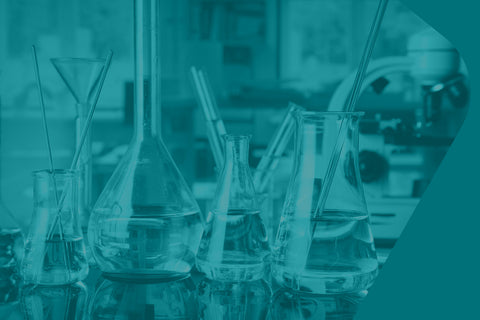
One of the most frequently asked questions we get at Troscriptions is why we use polyethylene glycol (PEG for short) as the base/suspension media for our formulas.
There are a lot of very smart people who use our products (who are even smarter after they use our products!) so today, Tro Nation, let’s lay it all out on the table and allay your concern(s). After all, knowledge is (blue and orange) power. But! Before we dive deep, there are three things to say right from the get-go:
First, do not confuse polyethylene glycol with propylene glycol. The former is quite safe and a long-established FDA-approved drug delivery method used around the world, especially by compounding pharmacists (more on all of this later). The latter is antifreeze and will kill you if you drink it... so please don’t do that!
Second and third, our formulations using polyethylene glycol are both non-absorbable and very low dose, meaning that it does not get absorbed into your body and it will not cause gastrointestinal distress or any of those other symptoms/issues that you may have heard about.
But still... is polyethylene glycol really safe? And why did we decide to use it in our products? Read on to learn more!
What Exactly is Polyethylene Glycol?
Polyethylene glycol is also known as polyethylene oxide (PEO) or polyoxyethylene (POE) depending on its weight. These three names all refer to the same molecule, but PEG is preferred in the biomedical field, while PEO is preferred in the chemistry field.
The wide variety of polyethylene glycols available are made via the polymerization of ethylene oxide and most are in either liquid/low-melting solid form. Even though the physical properties and applications are different, the chemical properties remain virtually the same. These varying physical properties are attributed to the different PEG molecular weights and chain length effects [5].
Polyethylene Glycol History
Polyethylene glycol was first discovered in 1859 when A.V. Laurenco heated ethylene glycol and 1,2-dibromoethane, and isolated oligo(ethylene glycol)s by fractional distillation [1]. In 1953, Sperber et al. used PEG 4000 as a marker to trace the flow of water and solutes in sheep. This established PEG as a reliable marker in scientific investigation because of its chemical purity, non-absorbability, lack of toxicity, resistance to enzymes, and because it was very easy to accurately measure [1].
PEG found other uses as well, especially in the field of gastroenterology due to its solubility, unique osmotic properties, stability, strength, and because it stays in the intestinal lumen (i.e., is not systemically absorbed). Since the 1970s, high doses of PEG (>16 grams) have been used as a laxative and for colonoscopy preparation [1].
PEG also found use in the cosmetic industry. Since many types of PEG are hydrophilic (water loving), they are used as penetration enhancers for many topical products such as surfactants, cleansing agents, emulsifiers, skin conditioners, and humectants [2].
In pharmaceuticals, PEG is used as an inactive base/suspension of choice in several types of formulations including as a solvent, surfactant, ointments, and tablets/lozenges. In the mouth (and as a troche), PEG is ideal due to its slow dissolution rate (15 to 30 minutes) and water solubility. As a result, it is the gold standard base used to make troches by compounding pharmacists worldwide.
Another use for PEG is to attach it to different molecules, drugs, or proteins in a process called PEGylation [3]. This is achieved by covalently coupling PEG to a larger molecule. Once the molecule has PEG attached to it, it is classified as a PEGylated molecule. The benefits of this process include improved solubility, increased molecular size, the “masking” of a protein from the immune system, etc. PEGylation of therapeutic proteins has resulted in the improved treatment of diseases such as hepatitis C, leukemia, rheumatoid arthritis, Crohn’s disease, and more [3].
PEG Safety
PEG is a Generally Regarded as Safe (GRASS) ingredient that is approved by the FDA for use in a wide range of industries with very few safety concerns, especially when used orally and at low doses.
There have, however, been reports of PEG contamination with other chemicals, but at Troscriptions, ours is pharmaceutical grade and tested.
PEG side effects only occur at high oral doses and with IV/IM use. These can include flatulence, nausea, stomach cramps, diarrhea, a swollen abdomen, or allergic reactions [4]. Toxicity is very rare.
In addition, there have been some concerns about PEG and cancer risk, but there have been no studies showing this link. In fact, there are several studies that show that PEG may have anti-cancer properties in the colon and that it can be used as a carrier compound for other anti-cancer drugs and supplements.
Contraindications include:
- Suspected bowel obstruction
- Appendicitis
- Inflammatory bowel disease
- Perforated bowel
- Hypersensitivity to PEG
How We Use PEG at Troscriptions
As mentioned earlier, PEG is the gold standard for troche production by compounding pharmacists worldwide and is extremely safe when used at low doses. And Dr. Ted, along with the 3 other practicing physicians on the Troscriptions team, have been using buccal troches with PEG as a base for decades collectively.
During early troche R&D in 2019 (prior to launch in 2020), the team tried several potential bases but these alternatives either melted too slowly, too quickly, inactivated the troche ingredients, or weren’t heat stable.
So the team decided to use the safest pharmaceutical grade PEG (1450) on the market, at a low dose of < 500 mg per troche. This dose, for reference, is 32x lower than a potential laxative dose (16 grams or greater).
In addition, after extensive testing using PEG 1450, we found that it was the best base available to deliver our delicate ingredients to the buccal mucosa in pristine and precise condition, have them absorb over 15 to 30 minutes, and let them bypass first-pass metabolism, making them more bioavailable (and with a more rapid onset of action) compared to a tablet or capsule.
Sounds awesome, right? Because our buccal troches are and low dose PEG is safe, tried and true, FDA approved, orange + blue.
References
- Fordtran, J. S., & Hofmann, A. F. (2017). Seventy Years of Polyethylene Glycols in Gastroenterology: The Journey of PEG 4000 and 3350 From Nonabsorbable Marker to Colonoscopy Preparation to Osmotic Laxative. Gastroenterology, 152(4), 675–680. https://doi.org/10.1053/j.gastro.2017.01.027
- Jang, H. J., Shin, C. Y., & Kim, K. B. (2015). Safety Evaluation of Polyethylene Glycol (PEG) Compounds for Cosmetic Use. Toxicological research, 31(2), 105–136. https://doi.org/10.5487/TR.2015.31.2.105
- Veronese, F. M., & Mero, A. (2008). The impact of PEGylation on biological therapies. BioDrugs : clinical immunotherapeutics, biopharmaceuticals and gene therapy, 22(5), 315–329. https://doi.org/10.2165/00063030-200822050-00004
- Dabaja A, Dabaja A, Abbas M. Polyethylene Glycol. [Updated 2021 Dec 29]. In: StatPearls [Internet]. Treasure Island (FL): StatPearls Publishing; 2022 Jan-. Available from: https://www.ncbi.nlm.nih.gov/books/NBK557652/
- Al-Nasassrah, M. A., Podczeck, F., & Newton, J. M. (1998). The effect of an increase in chain length on the mechanical properties of polyethylene glycols. European journal of pharmaceutics and biopharmaceutics : official journal of Arbeitsgemeinschaft fur Pharmazeutische Verfahrenstechnik e.V, 46(1), 31–38. https://doi.org/10.1016/s0939-6411(97)00151-3
- PEG as anti-cancer
- PEG as carrie of anti-cancer compounds





Comments (1)
Looking forward to further studies upon this compound ☮️❤️🇺🇸